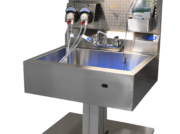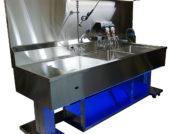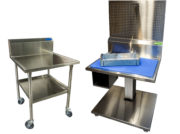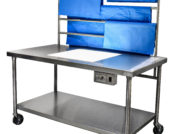
3 Ways Height Adjustable Sinks & Tables Improve Sterile Processing Workflow
According to the Occupational Safety and Health Administration (OSHA), “Ergonomics is the practice of designing equipment and work tasks to conform to the capability of the worker.” The ultimate purpose of this practice is to prevent injuries to staff while they are performing their tasks.
Preventable injuries create a host of negative consequences to workers and their employers, including:
- Pain and an inability to perform tasks
- Healthcare and worker’s compensation costs
- Temporary staffing costs
- Possible turnover and retraining costs
- Lost productivity and morale
- Lost revenue
OSHA’s Occupational Safety and Health Act of 1970 mandates that employers provide workplaces that are “free from recognized hazards that are causing or are likely to cause death or serious physical harm” to employees.
Sterile processing worker and workflow hazards
OSHA says hospitals are among the most hazardous places to work. During the 12 months of 2014, the Bureau of Labor Statistics recorded 294,000 nonfatal work-related illnesses and injuries in U.S. hospitals.
Ergonomic hazards in sterile processing departments (SPDs) are typically musculoskeletal disorders (MSD) associated with bending, reaching and repetitive motion tasks. Specifically, when working in sinks, technicians must sort, take apart, inspect and manually clean medical devices and instruments prior to assembly and sterilization or disinfection.”
These tasks are performed hundreds of times a week, and have typically been done while standing at static, deep sinks designed for the restaurant industry. Workers spend hours on their feet each day inspecting instruments and trays and wrapping each tray for sterilization. These tasks are often performed at a non-adjustable workstation that is not designed with staff safety in mind.
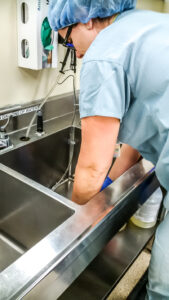 Focus on sterile processing ergonomics
Focus on sterile processing ergonomics
Whether they are performed in the GI department or the sterile processing department, reprocessing tasks are rife with potentially uncomfortable activities. These range from prolonged standing in one place, to awkward postures and repeated extreme bending, or performing repetitive wrist and arm movements that can cause pain and numbness. Some ergonomic solutions were designed to be added to existing department equipment. However, when a department is ready to remodel, or a new facility is being built, an opportunity is created to identify ergonomic hazards and address them more thoroughly through better designed manual cleaning workflows and permanently installed injury-prevention solutions.
OSHA has provided specific “possible solutions” to help address ergonomic injuries in the SPD (also known as Central Supply). They are intended to be applied to other similar work areas in the hospital. Among other suggestions, they include:
- Redesign workstations so packaging and equipment can be reached while maintaining elbows close to the body
- Use height-adjustable work surfaces
- Minimize prolonged overhead activity (to avoid reaching over shoulder height)
In addition, the American National Standards Institute (ANSI) and the Association for the Advancement of Medical Instrumentation (AAMI) issued a joint document, the ANSI/AAMI ST79: 2017, 3.3.6.1.3, which offers more detailed recommendations for setting up a decontamination area: “Ergonomic factors affecting worker safety and comfort should be considered when designing work spaces in the decontamination area, including: a) adjustable counters, sinks, and work surfaces positioned at heights that take into account the average height of the employees and the tasks to be performed at each location.”
The standard also states:
“Designing the area to facilitate efficient work flow and to provide adequate space for necessary equipment can reduce the potential for cross-contamination and enhance efficiency. Considering ergonomic factors during the design phase can help prevent worker injury.”
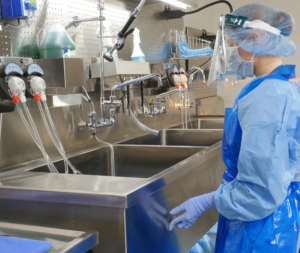 All utility sinks are not healthcare reprocessing sinks!
All utility sinks are not healthcare reprocessing sinks!
Every effort should be made to make the sink workstation as ergonomic as possible since it is the primary pre-cleaning work site. In the past, healthcare facilities had few options for sinks that could be used to reprocess devices. Their stainless steel sinks, not designed for healthcare functions, were unnecessarily deep. When used for healthcare instrument reprocessing activities, they have been a source of MSD of the hip, back, shoulder, and arm.
All prep and pack tables are not equal
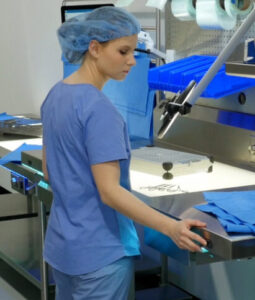 Workstations in the assembly area of sterile processing are one of the most critical pieces of equipment required to properly inspect and package instruments prior to sterilization. Workstations without ergonomic considerations are a culprit in back, hip, shoulder, arm, and eye strain.
Workstations in the assembly area of sterile processing are one of the most critical pieces of equipment required to properly inspect and package instruments prior to sterilization. Workstations without ergonomic considerations are a culprit in back, hip, shoulder, arm, and eye strain.
Incorporating a height-adjustable countertop as well as an attached pegboard allows users to raise or lower the workstation to meet their height while also allowing supplies and tools to be within easy reach. Attached task lights also move with the height-adjustability of the workstation, aiding in reducing eye and neck strain during inspection tasks.
Healthcare manufacturers identified the need to supply more ergonomic equipment and are developing better tools for these critical functions.
Workflow is essential to productivity
It is important to understand the flow of tasks and activities, the challenges and bottlenecks, the specific items being processed, and which specific processes are being used. In addition, the workflow requirements of all reprocessing stakeholders must be considered: Technicians, facility management, and the infection control department. Everyone should express their objectives and challenges in order to design the best solution for all. Planning for inventory growth and turnover is also a consideration for this area.
Three ways height-adjustable sinks and workstations improve workflow
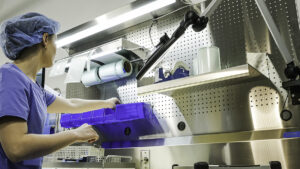 1. Height-adjustable sinks and workstation allow for less strain and minimize overhead activity
1. Height-adjustable sinks and workstation allow for less strain and minimize overhead activity
A height-adjustable sink or workstation allows fully customizable placement of the tools for individual technicians and brings items closer to the user. A height-adjustable pegboard and other movable hanging storage systems bring tools to users’ fingertips. Height adjustment on sinks and workstations enable the optimal ergonomic working height setting and head tilt for virtually any user, to help avoid strain and injury.
2. Ability to rotate workers through repetitive tasks
The ability to instantly customize the height and reach of a sink or workstation electronically with the push of a button, makes it fast and easy to rotate staff members with different ergonomic needs and capabilities at the sink and workstation.
3. Reducing the Clutter Factor
There is a strong indirect correlation between clutter and productivity in any workplace. Cluttered workstations add to workers’ time and effort, add to personal stress and morale, and can eventually affect the quality of work. In healthcare reprocessing areas, poor job quality can have a much more serious consequence: It can affect worker and patient health and safety.
Reprocessing areas are typically complex environments, with numerous cleaning tools, instructions, jugs of chemistries, device parts, packaging and assembly supplies in and around the work areas. Clutter and disorganization are very common conditions in these work areas because of the inherent nature of the work. A messy workspace requires more reaching, untangling and other musculoskeletal activity, which adds to the ergonomic stressors already in play. Additionally, heavily cluttered areas also carry the risk of becoming a breeding ground for organisms that can contaminate surfaces, tools and devices.
 Improve your sterile processing workflow with the right tools
Improve your sterile processing workflow with the right tools
Before selecting a sink or workstation intended to be used as a medical device reprocessing tool, hospital decision-makers must consider this: Are they using a local fabricator or supplier with general sink design experience, or consulting a healthcare specialty manufacturer with extensive research and observation-based knowledge of the reprocessing function and its related requirements?
OSHA has made it clear that attention to proper ergonomics helps reduce injuries and discomfort that can affect a worker’s ability to function, and that identifying and addressing ergonomic issues should be a mandatory practice for all industries. Providing an ergonomic workplace can also help employers reduce healthcare and other costs related to avoidable injuries, so it is in their best interest to do so.
By installing and using a powered, auto-height adjustable healthcare reprocessing sink or prep and pack workstation, and providing ergonomic storage to organize the immediate workspace, sterile processing management can eliminate unnecessary pain and costs while developing a safe, efficient and highly productive workflow to better support clinical areas of their hospital. These industry-specific tools provide a simple and valuable solution for healthcare providers.
Learn more about Pure Processing height-adjustable prep and pack tables and reprocessing sinks, which feature adjustable pegboard and shelving accessories to meet your workflow and workplace goals.
References
- U.S. Bureau of Labor Statistics (2016). Hospital workers suffered 294,000 nonfatal workplace injuries and illnesses in 2014. TED: The Economics Daily. Accessed online 10/27/20. https://www.bls.gov/opub/ted/2016/hospital-workers-suffered-294000-nonfatal-workplace-injuries-and-illnesses-in-2014.htm
- United States Department of Labor. Healthcare wide hazards. Occupational Health and Safety Administration. Accessed online 10/26/20. https://www.osha.gov/SLTC/etools/hospital/hazards/ergo/ergo.html
- The Joint Commission (2014). OSHA worker safety in hospitals program launched online. Environment of Care News, April 2014, Volume 17, Issue 4. Accessed online 10/27/20. http://www.jcrinc.com/assets/1/7/EC-News-Apr-2014-1.pdf
- Centers for Disease Control and Prevention. Healthcare workers. The National Institute for Occupational Safety and Health (NIOSH). Accessed online 10/26/20. http://www.cdc.gov/niosh/topics/healthcare/default.html
- United States Department of Labor. Central supply. Occupational Safety and Health Administration. Accessed online 10/26/20. https://www.osha.gov/SLTC/etools/hospital/central/central.html
- United States Department of Labor. Occupational Safety and Health Administration. Accessed online 10/26/20. https://www.oshatrain.org/courses/pdf/OSHAErgonomics.pdf
- Dawson, Lawrence (2008). 6 reasons to clean out the clutter. Industrial Safety and Hygiene News. Accessed online 10/26/20. http://www.ishn.com/articles/87360-6-reasons-to-clean-out-the-clutter
- Association for the Advancement of Medical Instrumentation (2017). ANSI/AAMI ST79:2017, Comprehensive guide to steam sterilization and sterility assurance in healthcare facilities. Accessed online 10/26/20.




